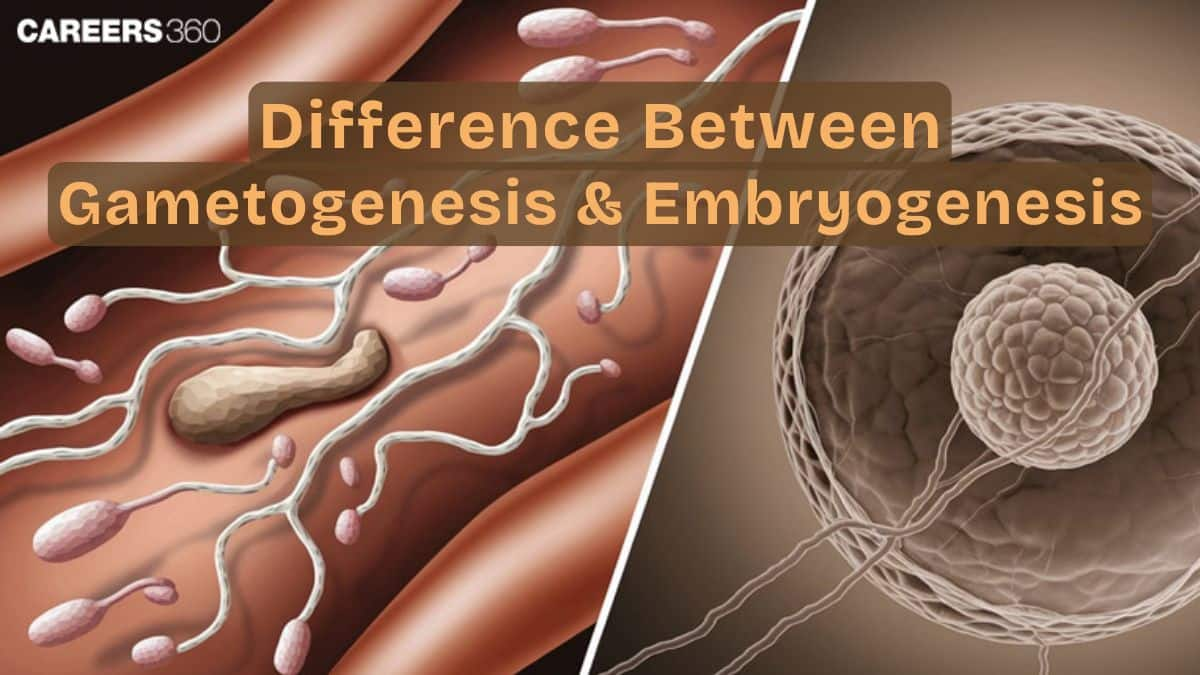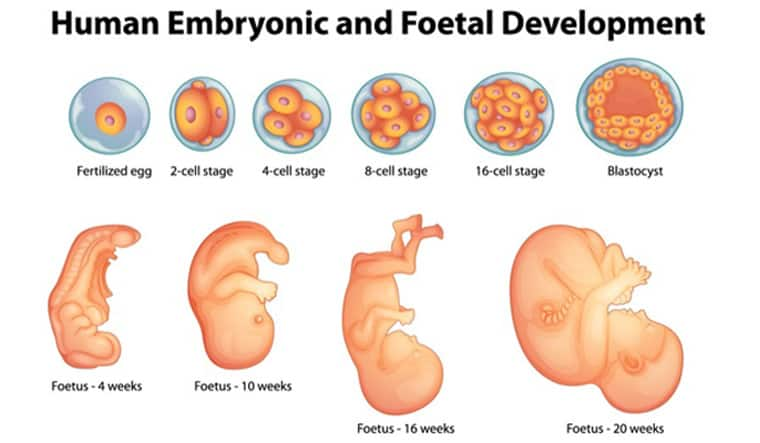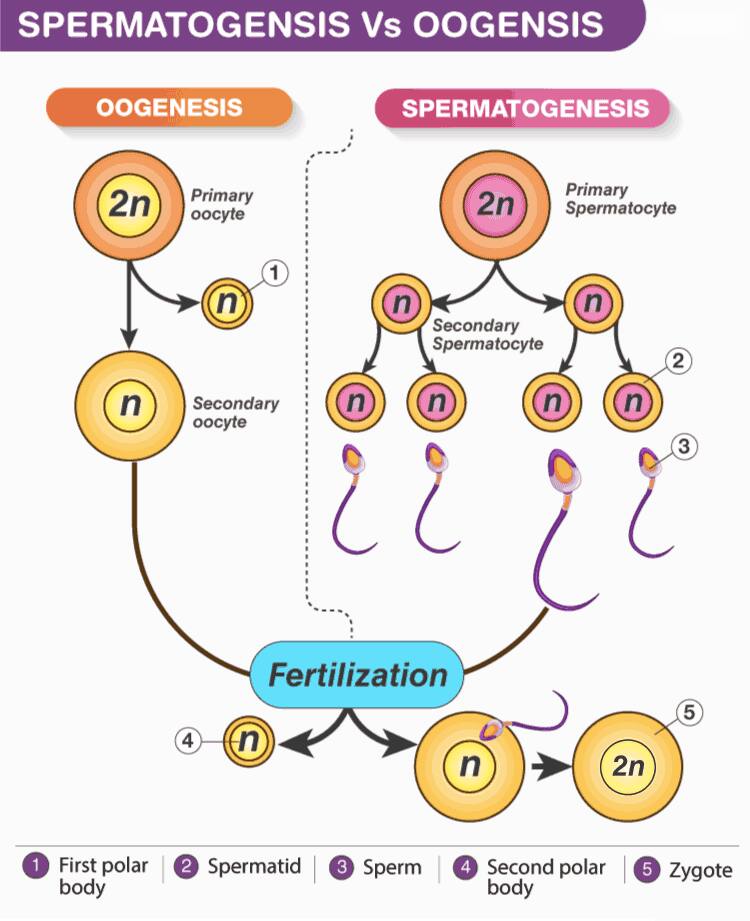Difference Between Gametogenesis And Embryogenesis
Gametogenesis and embryogenesis are two sequential yet distinct processes: gametogenesis forms haploid gametes, while embryogenesis transforms the zygote into an embryo. Both involve regulated cell division, differentiation, and hormonal control but differ fundamentally in purpose and biological outcome. These differences form a high-yield NEET concept frequently asked in reproduction and developmental biology chapters.
This Story also Contains
- What Is Gametogenesis?
- Types of Gametogenesis
- What Is Embryogenesis?
- Gametogenesis vs Embryogenesis (Comparison Table)
- Factors Influencing Gametogenesis And Embryogenesis
- Disorders Related to Gametogenesis
- Disorders Related to Embryogenesis
- Gametogenesis vs Embryogenesis NEET MCQs (With Answers & Explanations)

What Is Gametogenesis?
Gametogenesis is the development of gametes (sex cells) within the gonads—the ovaries and testes. It is a significant part of sexual reproduction, ensuring genetic material variability and perpetuation of the species.
Types of Gametogenesis
The two types of Gametogenesis are:
Spermatogenesis
It means the production of sperm cells within the testes.
It implies the division and differentiation of spermatogonia to form mature spermatozoa.
Oogenesis
The process of formation of egg cells in ovaries.
It is the development of oogonia to one ovum per cycle of menstruation.
What Is Embryogenesis?
It is the process of development of a fertilized egg, called the zygote, into a fully formed embryo. Embryogenesis is a process quintessential to the formative development of a new organism and consists of successive phases of cell division, differentiation, and morphogenesis.
Stages Of Embryogenesis
Fertilization: The sperm and egg combine to produce a single zygote.
Cleavage: Rapid mitotic divisions of a zygote without growth give rise to a multicellular structure called a blastula.
Blastulation: The process of the formation of the blastula, a hollow ball of cells.
Gastrulation: Rearrangement of cells in the blastula to form three germ layers: the ectoderm, mesoderm, and endoderm.
Organogenesis: Development of organs and tissues from the germ layers.

Gametogenesis vs Embryogenesis (Comparison Table)
The difference between gametogenesis and embryogenesis is:
Feature | Gametogenesis | Embryogenesis |
Process and Purpose | Formation of gametes (sperm and egg cells). | Development of a fertilized egg into a fully formed embryo. |
Stages and Duration | Involves meiosis and differentiation. | Involves cell division, differentiation, and morphogenesis. |
Cell Division Type | Meiosis. | Mitosis. |
Result | Formation of haploid gametes. | Formation of a multicellular diploid organism. |
Biological Significance | Ensures genetic diversity and sexual reproduction. | Development of a new organism from a single cell. |

Factors Influencing Gametogenesis And Embryogenesis
The shared factors which influence gamete-genesis and embryogenesis include the following:
Genetic Factors
The inherited genetic conditions can influence the process of gamete-genesis and embryogenesis.
Mutations can cause disorders either in gamete production or embryonic development.
Hormonal Regulation
Gametogenesis is mainly controlled by hormones such as FSH and LH.
Maternal hormones and growth factors control embryogenesis.
Environmental Factors
Toxin/radiation exposure adversely affects both processes.
Nutritional status and maternal health are essential for embryogenesis to take place successfully.
Disorders Related to Gametogenesis
The disorders related to gametogenesis are:
Infertility
Inability to produce any viable sperm or eggs.
Polycystic Ovary Syndrome (PCOS)
Hormonal disorder causing problems in oogenesis.
Disorders Related to Embryogenesis
Some of the disorders related to embryogenesis are:
Congenital Anomaly
It is a structural or functional abnormality present at birth.
Miscarriage
This refers to the expulsion of the embryo or foetus before it becomes viable outside the uterus.
Gametogenesis vs Embryogenesis NEET MCQs (With Answers & Explanations)
Important topics for NEET are:
Types of Gametogenesis
Stages of Embryogenesis
Practice Questions for NEET
Q1. Meiocytes are also known as
1) Gamete sister cell
2) Gamete
3) Gamete mother cell
4) Gametophyte
Correct answer: 3) Gamete Mother Cell
Explanation:
In diploid organisms, specialised cells called meiocytes (gamete mother cells) undergo meiosis. At the end of meiosis, only one set of chromosomes gets incorporated into each gamete. At the end of meiosis, only one set of chromosomes gets incorporated into each gamete, ensuring genetic diversity. These haploid gametes, when fused during fertilization, restore the diploid chromosome number, leading to the formation of a new organism.
Hence, the correct answer is option 3) Gamete mother cell.
Q2. Those organisms having both male and female sex organs are
1) Heterothallic
2) Homothallic
3) Monoecious
4) Both b and c
Correct answer: 4) Both b and c
Explanation:
Homothallic or monoecious plants have both the male and the female reproductive parts on the same plant, therefore allowing the making of both sorts of gametes. This makes self-fertilization possible increases reproductive productivity and ensures that the species can survive. These are the varieties of corn and cucumbers, the male flowers produce pollens, and the female produce ovules. Such plants can therefore survive in a wide range of environments by maximizing their reproductive potential.
Hence the correct answer is option 4) Both (b) and (c).
Q3. In majority of sexually reproducing organisms the gametes produced are of two morphologically distinct types. Choose those organisms in the given options
1) Fucus
2) Homo sapiens
3) Cladophora
4) More than one correct
Correct answer: 4) More than one correct
Explanation:
Heterogametes -
In a majority of sexually reproducing organisms, the gametes produced are of two morphologically distinct types (heterogametes).
In such organisms, the male gamete is called the antherozoid or sperm and the female gamete is called the egg or ovum. E.g. Heterogametes of Fucus (an alga) and Heterogametes of Homo Sapiens (human beings).
Hence, the correct answer is option 4) more than one correct answers.
Also Read:
Frequently Asked Questions (FAQs)
Gametogenesis is the process of forming gametes (sex cells), while embryogenesis is the development of an embryo from a fertilized egg.
The stages of embryogenesis include fertilization, cleavage, blastulation, gastrulation, and organogenesis.
Spermatogenesis in males continuously produces sperm cells, while oogenesis produces egg cells and only releases one mature ovum per menstrual cycle.
These factors include genetic, hormonal, and environmental ones like toxins, nutrition etc.
Common disorders include congenital anomalies and miscarriages caused by genetic, environmental, or hormonal problems.
